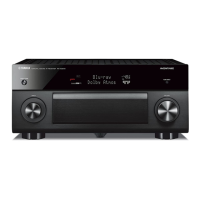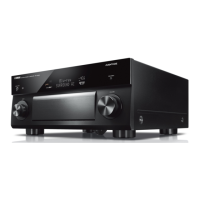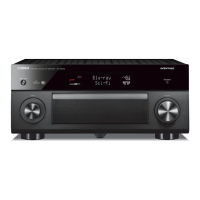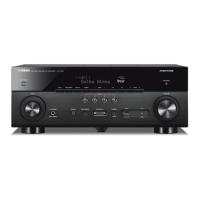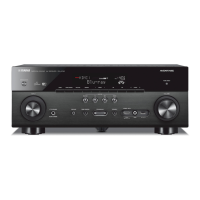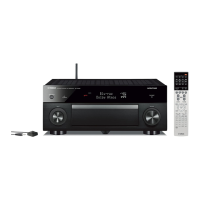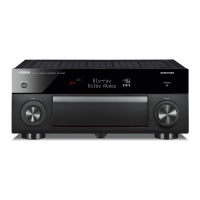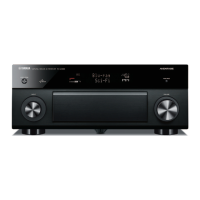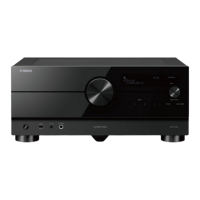Do you have a question about the Yamaha AVENTAGE RX-A3050 and is the answer not in the manual?
Overview of the unit's capabilities and supported content types.
Describes Yamaha's DSP technology for creating movie theater sound fields.
Details Yamaha's flagship 3D sound field playback technology.
Explains YPAO-R.S.C. for reducing unwanted reflections.
Describes automatic adjustment of high and low frequency levels.
Details measurement of speaker angles and heights for 3D sound fields.
Details Hi-bit high-sampling extension for enhanced music playback.
Explains processing for improving video quality from various sources.
Information on connecting front speakers for better quality or expanding the system.
Allows playback of different sources in multiple rooms.
Control the unit remotely using a smartphone or tablet.
Assists with cable connections and AV receiver setup.
Identifies controls and indicators on the front panel of the unit.
Details the functions of buttons and jacks located inside the front panel.
Details all input and output jacks on the rear panel of the unit.
Explains the purpose and operation of each button on the remote control.
Step-by-step guide for initial setup and connections.
Details the role of each speaker and recommended placement.
Guidance on positioning speakers based on the number of channels.
Using four internal amplifiers for higher quality front speaker sound.
Using an external amplifier to build an extended system.
Using excess amplifiers for stereo speakers in another room.
Instructions for connecting front speakers supporting bi-amp connections.
Details on connecting speakers for Zone2 and Zone3.
Steps for connecting the TV using an HDMI cable for video and audio.
Connecting the TV using component video and audio cables.
Connecting the TV using composite video and audio cables.
Guide for connecting video sources like BD/DVD players.
Steps for connecting playback devices via HDMI.
Instructions for connecting CD players, MD players, and turntables.
Steps for connecting the unit to a router using a network cable.
Instructions for setting up the wireless antenna for network connection.
Selects multi-point or single-point measurement for YPAO.
Enables/disables angle and height measurement for presence speakers.
Procedure for performing YPAO measurement at a single location.
Details on how to view and interpret YPAO measurement outcomes.
Steps to connect the unit to a wireless router (access point).
Connecting a mobile device directly to the unit without a router.
Using an iOS device to share network settings with the unit.
Easy wireless setup using the WPS button.
Options for connecting when WPS is not supported.
Steps to turn on devices, select input, and adjust volume.
Choosing which HDMI OUT jacks to use for signal output.
Registering input source and sound program to a SCENE key.
Reproduces surround sound using front speakers.
Enjoys surround sound with 5 speakers placed in the front.
Enjoy high fidelity sound by reducing electrical noise.
Enhances compressed music with added depth and breadth.
Manually tuning into radio stations by frequency.
Saving radio stations as presets for easy access.
Tuning into registered radio stations using preset numbers.
Connects and plays music from Bluetooth devices like smartphones.
Instructions for connecting an iPod using a USB cable.
Steps to connect USB storage devices like flash drives.
Configuring Windows Media Player for media sharing.
Instructions for listening to internet radio stations.
Playing music from iTunes/iPod using AirPlay.
Illustrations of various multi-zone setup scenarios.
Playing music through speakers in different rooms.
Playing the main zone music simultaneously in all zones.
Saving favorite USB/network content to shortcut numbers.
Accessing saved items using shortcut numbers.
Changing the input source and its icon.
Configures decode type, DSP level, delay, room size, and reverb.
Adjusts volume, balance, and height for stereo modes.
Configures Center Spread, Panorama, Center Width, and Dimension.
Selects the speaker system configuration.
Enables remote control of a TV using the unit's remote.
Controls TV input, volume, channels, and power.
Assigns codes to operate playback devices via remote.
Controls playback devices after registering their codes.
Explains HDMI Control capabilities and setup requirements.
| Channels | 9.2 |
|---|---|
| Amplifier Type | Discrete |
| Power Output (8 ohms, 20 Hz-20 kHz, 0.06% THD, 2-ch driven) | 150 W |
| Rated Output Power (20Hz-20kHz, 2ch driven) | 150 W |
| HDMI Inputs | 8 |
| HDMI Outputs | 2 |
| Network Connectivity | Ethernet, Wi-Fi |
| USB Input | 1 |
| YPAO Calibration | Yes |
| Maximum Effective Output Power (1kHz, 1ch driven) | 230 W |
| Surround Sound Processing | Dolby Atmos, DTS:X |
| Video Upscaling | 4K |
| Audio Inputs | 9 |
| Audio Outputs | 2 |
| Speaker Outputs | 11 |
| Dimensions (W x H x D) | 435 x 192 x 474 mm |
